The Robotic Lawn Mower Market is estimated to be valued at USD 1.2 billion in 2025 and is projected to reach USD 3.7 billion by 2035, registering a compound annual growth rate (CAGR) of 11.9% over the forecast period.
The Robotic Lawn Mower market is experiencing steady growth, driven by the increasing adoption of automated landscaping solutions in residential and commercial environments. Rising consumer demand for time-saving, energy-efficient, and low-maintenance gardening solutions is fueling market expansion. Technological advancements in navigation systems, obstacle detection, and AI-based mowing patterns are enhancing the efficiency and reliability of robotic mowers.
Growing awareness of sustainable lawn care practices and the environmental benefits of reduced fuel-powered equipment usage is further supporting adoption. Integration with smart home ecosystems and IoT-enabled devices allows for remote monitoring and customization, increasing the appeal of robotic lawn mowers to homeowners.
The market is also being driven by investments from manufacturers in product innovation, offering extended battery life, larger cutting areas, and quieter operation As consumers continue to prioritize convenience, efficiency, and smart home compatibility, the Robotic Lawn Mower market is poised for sustained growth, with new product launches and expanding distribution networks further reinforcing market dynamics and long-term opportunities for manufacturers.
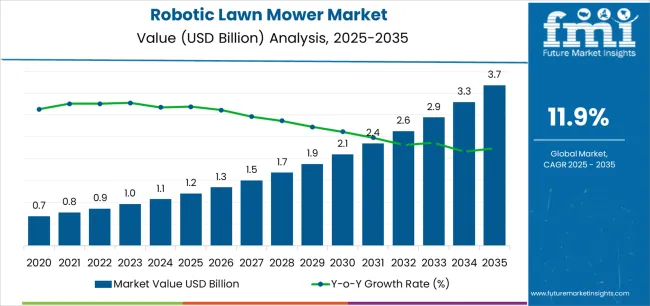
| Metric | Value |
|---|---|
| Robotic Lawn Mower Market Estimated Value in (2025 E) | USD 1.2 billion |
| Robotic Lawn Mower Market Forecast Value in (2035 F) | USD 3.7 billion |
| Forecast CAGR (2025 to 2035) | 11.9% |
The market is segmented by Working Area, End Use, and Sales Channel and region. By Working Area, the market is divided into Large Area, Medium Area, and Small Area. In terms of End Use, the market is classified into Residential and Commercial. Based on Sales Channel, the market is segmented into Offline and Online. Regionally, the market is classified into North America, Latin America, Western Europe, Eastern Europe, Balkan & Baltic Countries, Russia & Belarus, Central Asia, East Asia, South Asia & Pacific, and the Middle East & Africa.
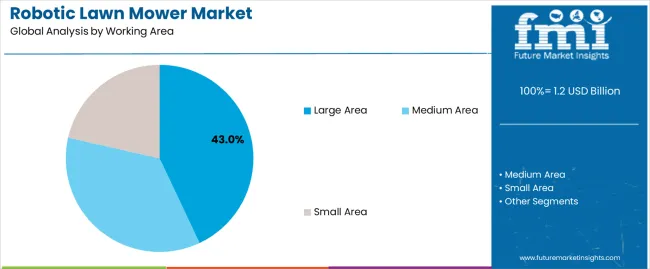
The large area working segment is projected to hold 43.0% of the market revenue in 2025, establishing it as the leading working area category. Growth in this segment is being driven by the increasing demand for mowers capable of handling expansive lawns and commercial landscapes efficiently. These robotic mowers are designed with extended battery life, larger cutting widths, and advanced navigation systems to ensure thorough coverage and reduce mowing time.
AI-enabled route optimization and obstacle detection further enhance performance and reliability. The ability to operate autonomously across large properties reduces labor requirements, making them highly attractive to both residential and commercial users with extensive lawns.
Increasing investments in property maintenance automation, along with consumer preference for low-maintenance and sustainable landscaping solutions, are supporting adoption As the demand for time-efficient and high-performance mowing solutions grows, large area robotic lawn mowers are expected to maintain their market leadership, supported by continuous technological innovation and expanding product portfolios that cater to varying property sizes.
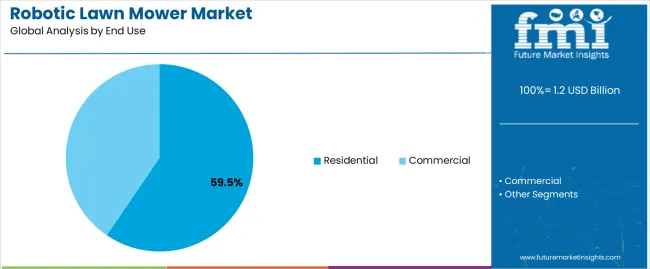
The residential end-use segment is expected to account for 59.5% of the market revenue in 2025, making it the leading end-use category. Growth is driven by the rising adoption of robotic lawn mowers in private households where convenience, time savings, and aesthetic lawn maintenance are key priorities. Advanced features such as programmable schedules, smart sensors, and integration with home automation systems enhance usability and consumer appeal.
Homeowners are increasingly seeking solutions that minimize manual labor while providing efficient and consistent lawn care. Environmental considerations, including reduced emissions and quieter operation compared to traditional mowers, further support adoption. Manufacturers are focusing on user-friendly designs, longer battery life, and enhanced safety features to meet residential demand.
As urbanization and smart home adoption continue to rise, residential consumers are expected to remain the primary driver of market growth The emphasis on convenience, sustainability, and automation is reinforcing the leading position of this segment in the Robotic Lawn Mower market.
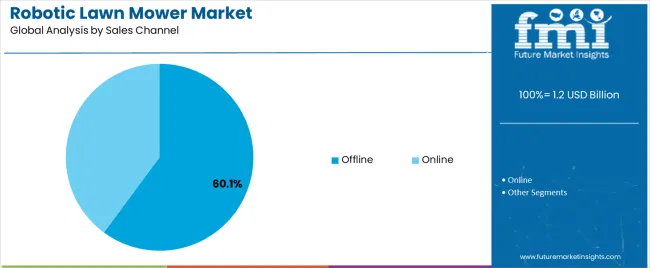
The offline sales channel segment is projected to hold 60.1% of the market revenue in 2025, establishing it as the leading distribution channel. Growth in this segment is driven by the continued preference of consumers to physically evaluate product quality, performance, and features before purchase.
Retail showrooms, specialty stores, and garden equipment outlets provide opportunities for hands-on demonstrations, guidance from sales experts, and immediate product availability, which enhances consumer confidence. The offline channel also enables manufacturers to offer bundled services, warranty support, and maintenance packages that strengthen customer satisfaction.
Despite the growth of e-commerce, traditional retail remains critical for high-value, technologically advanced products like robotic lawn mowers, particularly for residential consumers seeking expert consultation As awareness of robotic mowing solutions expands and consumers increasingly value personalized guidance, the offline sales channel is expected to remain the dominant distribution method, supporting market expansion and fostering stronger brand recognition and trust in the Robotic Lawn Mower market.
| Historical CAGR (2020 to 2025) | 11% |
|---|---|
| Forecast CAGR (2025 to 2035) | 12.50% |
The momentum of the market development over the past four years between 2020 and 2025 was interesting for market watchers. There was a CAGR of 11% which pointed to the gradual but steady adoption of the automated lawn care services. This was driven by a dynamic mix of factors which included both a heightened consciousness of environmental sustainability and a rising need for smart home inventions.
Looking forward to the estimated increase of a 12.50% CAGR from 2025 to 2035, the market is on the edge of a transformative change. Such acceleration, which is expected to be due to the integration of artificial intelligence and machine learning algorithms, is anticipated to be the main driver of that.
Moreover, changing tastes among consumers toward urban gardening and outdoor leisure activities is a market that is not yet fully saturated hence it represents an area of great untapped potential for manufacturing and service providers to innovate and create unique products and services.
Localization for Global Markets
Just a cookie-cutter approach cannot serve the lawns of the world with so much difference. Manufacturers understand the importance of the regional variation with mowers that are not only designed for specific grass types, weather conditions, and yard sizes but also optimized for different countries, to satisfy an even wider range of customer needs and grow in the global market.
Multitasking Yard Care Solutions
The functionality of robotic lawn mowers is expanding not just in simple grass-cutting but also in other areas. Sophisticated models would have the potential to add features such as edging, leaf collection, and even snow removal accessories thereby changing them into all-rounder lawn care assistants.
Focus on Eco-Conscious Solutions
Environmental consciousness is a strong aspect of the market. Sustainability in the field is moving forward, with manufacturers focusing on features such as quiet operation, energy efficiency, and low maintenance instead.
Noise Reduction for a Peaceful Lawn Care Experience
The loud sound from the lawn mowers is a big problem for most of the people who live in the neighborhood. Manufacturers introducing sophisticated motor designs and blade technology are solving the problem of noise and giving a more blissful experience of lawn care.
| Segment | Estimated Market Share in 2025 |
|---|---|
| Large | 43% |
| Residential | 59.50% |
Robotic lawn mowers for large working areas are said to gain 43% of the market share in 2025. This data shows that the interest in AI-driven lawn care systems that can manage large yards and green areas is increasing. Such equipment is usually fitted with features that target the particular hindrances of large properties.
The long lifetime of these devices enables them to work uninterrupted for longer periods and cover large areas without having to be frequently charged. Highly developed navigation systems help them to optimize the process of mapping and navigating the complex terrain bypassing the obstacles and providing full coverage.
Furthermore, some models are designed with blades that self-adjust to accommodate uneven ground conditions. It is this function of extended operation, precise navigation, and terrain adaptability that makes these mowers the best choice for large estates, commercial properties, and extensive lawns.
The residential sector holds around 59.50% share in 2025. This dominance brings up the fact that robotic lawn mowers are getting widely adopted by homeowners who seek to have a simple way of maintaining their lawns.
Convenience is the main factor for people to adopt residential use. This leaves homeowners the chance to reclaim their pastime hours and own a neatly mowed lawn without the physically exhausting effort or noise pollution of a conventional mower.
On the other hand, the features such as quiet operation, and efficient lawn maintenance are also other factors that cause the popularity of robotic lawn mowers to keep increasing within the residential sector. With the advancement of technology and the reduction of features, the residential segment is set to continue with its rising trend.
The analysis includes untapped opportunities for players that have not been exploited in key countries. It is projected that China and India are expected to give a major boost to suppliers of robotic lawn mowers. The United States, Japan, and Germany also become an attractive ground for startups despite trailing only a few points behind.
| Countries | CAGR till 2035 |
|---|---|
| United States | 14.50% |
| India | 18.60% |
| China | 16.70% |
| Japan | 12.80% |
| Germany | 13.40% |
The market in Japan is forecasted to grow at a rate of 12.80% CAGR until 2035, creating a lucrative opportunity. Here, accuracy and speed have completed their rule. Japanese consumers are known for their attention to detail and love of high-quality technology and are most likely attracted to lawn mowers that are equipped with advanced options.
Manufacturers in Tokyo and Okinawa are busy developing robotic land mowers with sophisticated navigation that can avoid obstacles and offer excellent cutting performance. The industry is moving toward a phase of consistent innovations by companies looking to dominate the regional market.
The United States has a stable and prosperous market for robotic lawn mower manufacturers. It is expected that the market progress at a CAGR of 14.50% till 2035 which is primarily driven by a need for convenience and time-saving solutions.
Existing air quality and worker safety regulations which are the two unavoidable matters encourage the deployment of automated lawn maintenance systems. There is also the growth of automation in landscaping services which calls for high-performing and dependable robotic lawn mowers.
Companies should first pay attention to user-friendly interfaces for simple start-up and operation, the robustness needed for the tough USA climate, and stable communication with landscape software.
China's whopping CAGR of 16.70% for lawn mowers reveals a market with a high potential for explosive growth. This high-speed growth is caused by the country's fast urbanization. With the expansion of the megacities, there is an increasing need for automation in lawn care of residential districts and commercial landscapes.
The increasing middle class having discretionary income is looking for labor-saving technology such as robotic lawn mowers. Manufacturers creating affordable models suitable for smaller yards in urban areas, and noise reduction technologies to comply with regulations in densely populated areas have the opportunity to capitalize on the expanding market and to make their presence felt in China.
The forecasted CAGR of 18.60% promises untapped expansion opportunities for robotic lawn mower manufacturers in India. Indian consumers of lawn mower believes that affordability is paramount. Keeping that in mind, manufacturers could look into the opportunities of developing the next generation of robotic lawn mowers at a friendly price point.
Startups are developing mowers designed for the common yards in India and possible features that could be suitable for the diverse weather changes within the country.
Market in Germany to mark expansion at a CAGR of 13.40% through 2035. Germans have been recognized as consumers who prefer advanced, cutting-edge technology that is precise and secure.
Manufacturers targeting such customers may include those whose products come with features like advanced navigation systems with superior obstacle avoidance for complex gardens, or strong security measures such as anti-theft technology and geofencing to prevent unauthorized use.
The market is flooded with such fierce competition characterized by increasing consumer desire for convenience and a global CAGR of more than 12.5%. With the Husqvarna, iRobot, and Robomow brands firmly established in the market as a premium player, the market is very competitive.
The trends are about to be questioned by new players, mostly from China, who are trying to face the established players with their aggressive pricing strategies. Also, tech firms like Samsung and LG are trying to get a share of this market by using their already well-established smart home ecosystems to create a user experience that is more integrated.
This sudden rise in the number of players is expanding the perimeter of innovation, involving AI-enabled navigation, voice control integration, and data-driven personalization as the new battlegrounds.
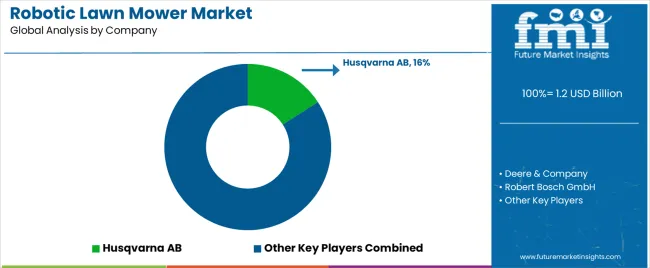
The global robotic lawn mower market is estimated to be valued at USD 1.2 billion in 2025.
The market size for the robotic lawn mower market is projected to reach USD 3.7 billion by 2035.
The robotic lawn mower market is expected to grow at a 11.9% CAGR between 2025 and 2035.
The key product types in robotic lawn mower market are large area, medium area and small area.
In terms of end use, residential segment to command 59.5% share in the robotic lawn mower market in 2025.






Full Research Suite comprises of:
Market outlook & trends analysis
Interviews & case studies
Strategic recommendations
Vendor profiles & capabilities analysis
5-year forecasts
8 regions and 60+ country-level data splits
Market segment data splits
12 months of continuous data updates
DELIVERED AS:
PDF EXCEL ONLINE
Robotic Warfare Market Size and Share Forecast Outlook 2025 to 2035
Robotics Welding Market Size and Share Forecast Outlook 2025 to 2035
Robotic Rehab Tools Market Analysis - Size, Share, and Forecast Outlook 2025 to 2035
Robotics-Assisted Telesurgery Market Size and Share Forecast Outlook 2025 to 2035
Robotic Packaging Machines Market Size and Share Forecast Outlook 2025 to 2035
Robotic Assisted Endovascular Systems Market Size and Share Forecast Outlook 2025 to 2035
Robotic Lung Biopsy Market Size and Share Forecast Outlook 2025 to 2035
Robotics as a Service (RaaS) Market Size and Share Forecast Outlook 2025 to 2035
Robotic X-ray Scanner Market Size and Share Forecast Outlook 2025 to 2035
Robotic Catheterization Systems Market Growth – Innovations, Trends & Forecast 2025-2035
Robotic Aseptic Syringe Filler Capper Market Size and Share Forecast Outlook 2025 to 2035
Robotic Vision Market Size and Share Forecast Outlook 2025 to 2035
Robotics Actuators Market Size and Share Forecast Outlook 2025 to 2035
Robotic Biopsy Devices Market Insights - Trends & Forecast 2025 to 2035
Robotic Palletizers & De-Palletizers Market Growth - Forecast 2025 to 2035
Robotic Vacuum Cleaners Market Growth - Trends & Demand from 2025 to 2035
The Robotics Market Analysis – Size, Share, and Forecast Outlook 2025 to 2035
Robotics Prototyping Market Trends - Growth & Forecast 2025 to 2035
Robotic Process Automation Market by Component, Operation, Industry & Region Forecast till 2025 to 2035
Competitive Landscape of Robotic Vacuum Cleaner Providers

Thank you!
You will receive an email from our Business Development Manager. Please be sure to check your SPAM/JUNK folder too.
Chat With
MaRIA